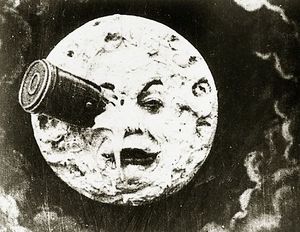Georges Méliès
Click here for Early Movie History category page |
Georges Méliès (✦December 8, 1861 – †January 21, 1938), full name Marie-Georges-Jean Méliès, was a French filmmaker famous for leading many technical and narrative developments in the earliest cinema. He was very innovative in the use of special effects. He accidentally discovered the stop trick, or substitution, in 1896, and was one of the first filmmakers to use multiple exposures, time-lapse photography, dissolves, and hand-painted color in his films. Because of his ability to seemingly manipulate and transform reality through cinematography, Méliès is sometimes referred to as the First "Cinemagician."
Biography
Méliès was born in Paris, where his family manufactured shoes. He had two older brothers, Henri and Gaston. Before making films, he was a stage magician at the Theatre Robert-Houdin.
In 1895, he became interested in film after seeing a demonstration of the Lumière brothers' camera. In 1897, he established a studio on a rooftop property in Montreuil. Actors performed in front of a painted set as inspired by the conventions of magic and musical theater. He directed 531 films between 1896 and 1914, ranging in length from one to forty minutes. In subject matter, these films are often similar to the magic theater shows that Méliès had been doing, containing "tricks" and impossible events, such as objects disappearing or changing size. These early special effects films were essentially devoid of plot. The special effects were used only to show what was possible, rather than enhance the overall film.
Melies early films were mostly composed of single in-camera effects, used for the entirety of the film. For example, after experimenting with multiple exposures, Melies created his film The One Man Band in which he played seven different characters simultaneously.
His most famous film is A Trip to the Moon (Le voyage dans la Lune) made in 1902, which includes the celebrated scene in which a spaceship hits the eye of the man in the moon. Also famous is The Impossible Voyage (Le voyage à travers l'impossible) from 1904. Both of these films are about strange voyages, somewhat in the style of Jules Verne. These are considered to be some of the most important early science fiction films, although their approach is closer to fantasy. In addition, horror cinema can be traced back to Georges Méliès's Le Manoir du diable (1896). A print of the film was acquired by Thomas Edison, who then duplicated and distributed it in the United States, where it achieved financial success; however, Edison did not pay any revenues to Méliès.
In 1913 Georges Méliès' film company was forced into bankruptcy by the large French and American studios, and his company was bought out of receivership by Pathé Frères. Méliès did not grasp the value of his films, and with some 500 films recorded on cellulose, the French Army seized most of this stock to be melted down into boot heels during World War I. Many of the other films were sold to be recycled into new films. As a result, many of his films do not exist today.
After being driven out of business, Méliès became a toy salesman at the Montparnasse station, with the assistance of funds collected by other filmmakers. In 1932 the Cinema Society gave Méliès a home in Château d'Orly. Georges Méliès was also awarded the Légion d'honneur (Legion of Honor), which was presented to him by Louis Lumière.
Méliès died in Paris and was buried in the Père Lachaise Cemetery.
His 1899 short film Cleopatra was believed to be a lost film until a copy was discovered in 2005 in Paris.
- More information is available at [ Wikipedia:Georges_Méliès ]
A Personal Note from Robin
In 2011, Martin Scorsese produced the film Hugo. It should be on every film buffs must-see viewing list.
See also [ Hugo (film) ]
External links
The Georges Méliès Collection
Chat rooms • What links here • Copyright info • Contact information • Category:Root
